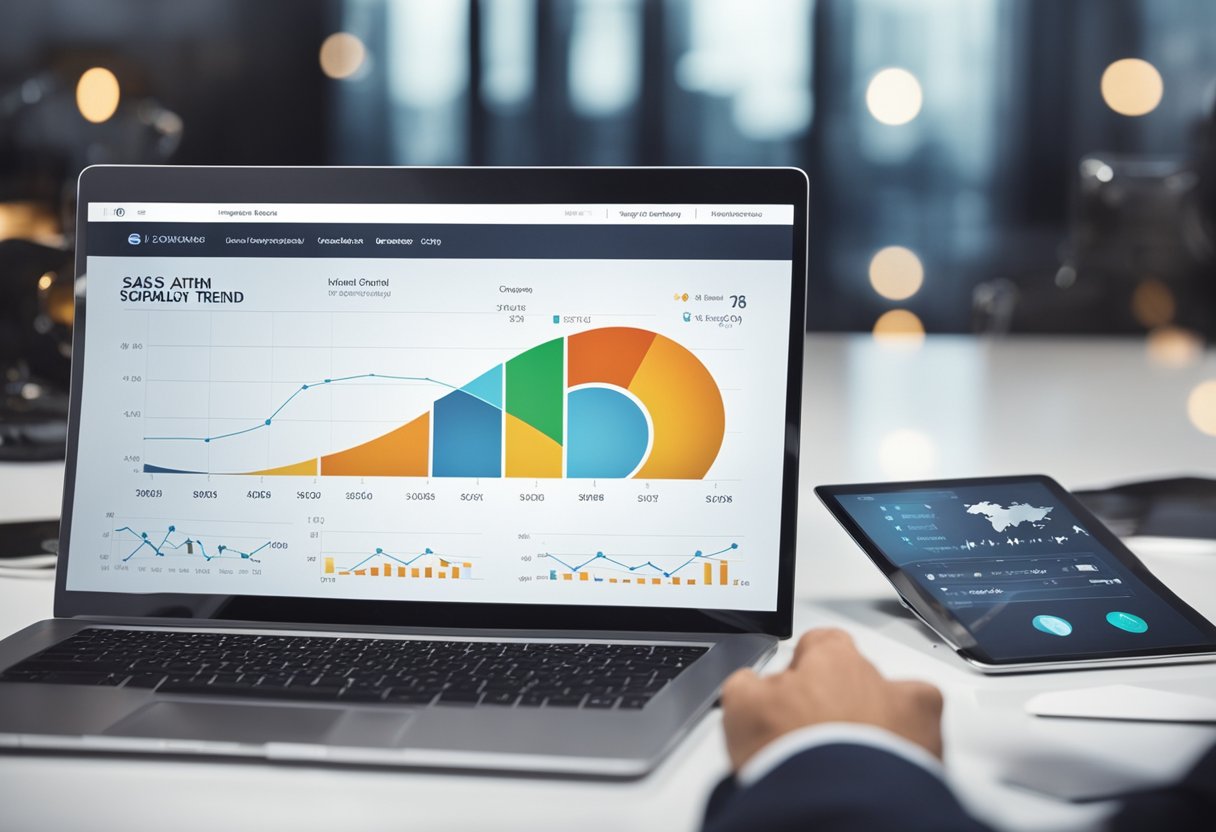Value investing in Software as a Service (SaaS) companies can be a rewarding investment strategy when executed with a deep understanding of the unique characteristics and metrics driving growth in the modern SaaS landscape. As the SaaS market has grown substantially in recent years, with a valuation of $130.69 billion in 2021 and expected to reach $716.52 billion by 2028, investors need to familiarize themselves with the specific attributes of SaaS businesses to make informed decisions.

Companies operating on SaaS models rely on a subscription-based approach, offering cloud-based software solutions to their clients. This leads to a dependable stream of recurring revenue and unique financial metrics such as churn rate, customer lifetime value (LTV), and customer acquisition cost (CAC) to consider when adopting a value-investing strategy in this space. Investors pursuing value investing in SaaS companies should be prepared to delve into these metrics, along with traditional financial analysis, to identify undervalued companies with strong growth potential.
Key Takeaways
- Value investing in SaaS requires understanding unique metrics and growth factors in the industry.
- A combination of traditional financial analysis and evaluation of SaaS-specific metrics is essential for identifying undervalued companies.
- Long-term growth potential and market dynamics play a significant role in shaping investment strategies for SaaS value investors.
Understanding SaaS
Defining Software as a Service (SaaS)
Software as a Service, or SaaS, is a software licensing and delivery model wherein applications are provided over the internet, instead of being installed on a user’s device. This eliminates the need for manual software updates, hardware maintenance, and reduces upfront costs for customers. SaaS enables users to access software from any device with an internet connection, making it a highly flexible and scalable option for businesses and individuals alike.
SaaS Industry Overview
The SaaS industry has experienced significant growth in recent years, with the market size expanding from a valuation of $113.82 billion in 2020 to $130.69 billion in 2021. It is projected to reach a staggering $716.52 billion by 2028. This growth can be attributed to the increasing adoption of cloud computing, as well as the rise in remote working, which has spurred the demand for accessible, efficient, and secure software solutions. Some notable examples of SaaS companies include Salesforce, Microsoft Office 365, and Zoom, among others.
Key Characteristics of SaaS Companies
SaaS companies possess certain unique characteristics that set them apart from traditional software providers. Some of these key features are:
-
Subscription-based revenue model: SaaS companies typically generate recurring revenue through subscription fees, providing clients with access to their software on a monthly, quarterly, or annual basis.
-
Scalability: The cloud-based nature of SaaS allows these companies to easily scale their offerings to accommodate a growing customer base without significant investment in infrastructure.
-
Lower upfront costs: By eliminating the need for physical hardware and ongoing maintenance, SaaS companies reduce the initial costs associated with software implementation for clients.
-
Regular updates and maintenance: SaaS providers can seamlessly roll out software updates and improvements, ensuring that customers always have access to the latest features and functionality.
-
Data analysis and usage insights: SaaS providers can collect and analyze usage data to better understand customer behavior and needs, allowing them to make data-driven decisions and provide targeted solutions.
The rapid growth of the SaaS industry, combined with its unique business characteristics, presents significant opportunities for value investors as they evaluate the potential of individual SaaS companies and their impact on the software landscape.
Fundamentals of Value Investing
Principles of Value Investing
Value investing is a strategy where investors aim to identify and purchase undervalued stocks with strong fundamentals, which have the potential for growth in the long term. Investors focused on value investing typically analyze financial metrics such as price-to-earnings and price-to-book ratios. They also consider companies’ debt-to-equity ratios, free cash flow, and other factors in order to estimate their intrinsic value.
One of the key principles in value investing is the concept of buying stocks at a discount, or with a margin of safety, to protect oneself from potential losses. Value investors often look for companies with sturdy balance sheets, consistent cash flows, and sustainable competitive advantages that can create value over time. As Warren Buffett once said, “Price is what you pay. Value is what you get.”
Adapting Value Investing to SaaS
In recent years, the rise of software as a service (SaaS) companies has created new opportunities and challenges for value investors. Traditionally, SaaS companies are valued differently compared to their non-SaaS counterparts. Some of the key metrics for valuing SaaS companies include annual recurring revenue (ARR), customer lifetime value (CLV), net revenue retention (NRR), and growth rates (source).
In order to apply value investing principles to SaaS companies, investors must adapt their approach for evaluating these organizations. Here are some steps:
-
Understand the business model: Value investors should take the time to comprehend the SaaS company’s offering, target market, and competitive landscape.
-
Focus on unit economics: Assessing key metrics such as customer acquisition cost (CAC), customer lifetime value (CLV), and net dollar retention (NDR) can provide insights into a SaaS company’s future profitability and growth potential.
-
Evaluate financial health: SaaS companies often require significant upfront investments and can therefore carry higher levels of debt. Investors should examine the company’s balance sheet, cash flow, and debt-to-equity ratio to gauge its financial stability.
-
Growth and value creation: SaaS companies with high growth rates and strong net revenue retention can be attractive, as they indicate increasing customer loyalty and the ability to cross-sell or upsell products, contributing to long-term value creation (source).
In conclusion, while the principles of value investing remain the same, the metrics used to evaluate SaaS companies differ from traditional industries. Adapting these principles to SaaS firms requires a deeper understanding of their business models, unit economics, and growth potential, enabling value investors to identify promising opportunities in this rapidly evolving sector.
Evaluating SaaS Companies
Revenue Metrics and Growth Indicators
When evaluating SaaS companies, one of the key factors to consider is their revenue metrics. This includes the company’s annual recurring revenue (ARR) and monthly recurring revenue (MRR) which are strong indicators of a SaaS company’s financial growth. It is also crucial to analyze their revenue growth rate over a certain period. High revenue growth rates indicate a strong market demand and a company’s ability to capture market share.
Another essential metric to look for is the company’s compound annual growth rate (CAGR), which helps determine its growth potential. A high CAGR suggests that the company has been able to sustain growth consistently and is likely to continue doing so in the future.
Customer Metrics
Customer metrics play a vital role in assessing the performance and health of SaaS companies. One of the most important metrics is churn rate, which measures the percentage of customers who cancel their subscriptions within a given period. Low churn rates indicate strong customer retention and satisfaction, as customers are likely to continue using the company’s products or services.
Another crucial customer metric to evaluate is the customer lifetime value (CLV). This metric determines the net profit a company can expect to make from a customer over their entire relationship. A high CLV suggests that customers provide significant value to the company and thus make a strong argument for investing in customer acquisition and retention strategies.
Operational Efficiency
Operational efficiency is critical to the success of any SaaS company, as it determines how well a company can scale and grow with minimal additional resources. One way to measure operational efficiency is through unit economics, which assess the company’s cost structure, particularly the cost of acquiring and retaining customers.
Efficient SaaS companies should demonstrate the ability to support the increasing number of customers while keeping operational costs relatively stable. This ability to scale, coupled with strong revenue growth and customer metrics, would indicate a potentially successful investment for value investors interested in SaaS companies.
Financial Analysis of SaaS Enterprises
Understanding SaaS Financial Statements
Analyzing financial statements is a critical aspect of valuing Software as a Service (SaaS) enterprises. Typical financial statements include the income statement, balance sheet, and cash flow statement. For SaaS companies, emphasis lies on understanding key metrics like recurring revenue, customer churn, and customer acquisition costs. These unique aspects require domain-specific knowledge to effectively assess the health and value of a SaaS business.
Revenue Multiples and Valuation Metrics
SaaS companies are often valued using revenue multiples, which compare their enterprise value to their revenues. Common revenue multiples used in SaaS valuation include Enterprise Value to Revenue (EV/Revenue) and Price to Sales (P/S) ratios. In addition to revenue multiples, other important SaaS valuation metrics include:
- Annual Recurring Revenue (ARR): The total amount of revenue generated from subscription-based products or services in a year.
- Monthly Recurring Revenue (MRR): The total amount of revenue generated from subscription-based products or services in a month.
- Growth rate: The percentage increase in revenue or profits over a specific period.
- Net Revenue Retention (NRR): A measure of revenue growth from existing customers, taking into account churn and upsells.
- Customer Churn: The percentage of customers who cancel their subscription within a given period.
A SaaS business, for example, may have an ARR of $7m and a growth rate of 55%, with an excellent NRR of 115%. According to SaaS valuation metrics, the company may have a valuation of $44m, highlighting the importance of these metrics in SaaS valuation.
Cash Flow and Profitability Analysis
Cash flow and profitability analysis helps in understanding the financial sustainability of a SaaS enterprise. Key measures include:
- EBITDA (Earnings Before Interest, Taxes, Depreciation, and Amortization): A measure of a company’s operating performance, excluding non-cash items and tax effects.
- Gross Margins: Gross profit as a percentage of revenue, reflecting the efficiency of a company’s production process.
- EBITDA Margin: EBITDA as a percentage of revenue, demonstrating a company’s profitability and operational efficiency.
Investors often analyze EBITDA and cash flows to understand a company’s ability to service debt, reinvest in growth initiatives, and reward shareholders. To calculate various cash flows and profitability ratios, it’s essential to examine the income statement and cash flow statement.
In conclusion, performing a thorough financial analysis of SaaS enterprises requires understanding unique aspects of their operations, focusing on metrics like ARR, MRR, and NRR. Incorporating traditional valuation tools like revenue multiples and cash flow analysis helps yield a comprehensive assessment of a SaaS company’s financial health and potential for long-term success.
SaaS Metrics for Long-Term Value
When assessing the long-term value in Software as a Service (SaaS) companies, understanding and analyzing various key metrics is crucial. The following are some essential SaaS metrics for value-focused investors to consider.
Annual Recurring Revenue (ARR): ARR measures the company’s ability to drive topline growth. It reflects the yearly revenue generated from subscriptions and is a significant indicator of a SaaS company’s stability and predictability source.
Net Revenue Retention (NRR): NRR is a metric that considers the revenue generated from existing customers and upgrades against revenue lost due to downgrades and cancellations. A high NRR indicates strong customer satisfaction and potential for overall growth source.
Monthly Recurring Revenue (MRR): MRR measures dependable revenue generated through monthly subscriptions, providing a sound metric for assessing the company’s revenue growth and identifying potential risks associated with decreased engagement or increased cancellations source.
Customer Acquisition Cost (CAC): CAC encompasses the marketing and sales expenses required to acquire a new customer. A lower CAC is a positive indicator for long-term profitability, since it means the company can efficiently attract new customers without incurring excessive costs.
Lifetime Value (LTV): LTV represents the total revenue a company can reasonably expect from a single customer during their engagement with the service. An effective LTV-to-CAC ratio should be greater than 3:1, indicating a healthy balance between the costs of acquiring customers and the revenue generated from their continued engagement source.
Evaluating Growth Potential of SaaS Startups

When investing in SaaS startups, it’s crucial to evaluate their growth potential. One way to achieve this is by examining key performance indicators (KPIs) and metrics that reflect the company’s financial health and market performance.
Customer Acquisition Cost (CAC) is an essential metric to consider. It represents the average cost of acquiring a new customer. A lower CAC indicates a more cost-effective marketing strategy, while a higher CAC may signal unsustainable growth. To find the CAC of a SaaS startup, you divide total marketing and sales expenses by the number of new customers acquired in a specific period. For instance, if a company has a CAC of $500 and an LTV of $1000, this suggests a promising growth potential.
Lifetime Value (LTV) is the average revenue a company can expect from a customer throughout their entire lifetime as a client. A high LTV indicates that customers are likely to generate more revenue for a longer period, demonstrating the company’s ability to retain and upsell to its clients.
A healthy LTV-to-CAC ratio is another crucial metric. A ratio greater than 3:1 is generally considered excellent, as it shows that the company can generate more than three times the revenue from a customer compared to its cost of acquiring them.
Other important metrics include:
- Annual Recurring Revenue (ARR): Reflects the company’s yearly subscription income and indicates customer retention and revenue predictability.
- Monthly Recurring Revenue (MRR): Similar to ARR but calculated on a monthly basis.
- Churn Rate: The percentage of customers who cancel their subscriptions over a given time period. A low churn rate indicates strong customer satisfaction and loyalty.
- Net Revenue Retention (NRR): Measures the revenue generated by existing customers over time, factoring in upsells, cross-sells, and churn. A high NRR signifies successful customer retention and expansion strategies.
SaaS startups should also focus on the aspect of scalability. Scalable companies can efficiently grow their customer base and revenues without requiring massive investments in resources or personnel. Long-term metrics such as CLTV and NRR can help evaluate a SaaS startup’s scalability.
Investors need to consider all these factors when evaluating the growth potential of a SaaS startup. By doing so, they can make informed decisions and maximize their chances of success in the world of SaaS investing.
Portfolio Allocation in SaaS

When allocating a portfolio in SaaS (Software as a Service) companies, it is essential to consider various factors that reflect the company’s performance and potential. Here are some key aspects to focus on while building a well-diversified SaaS portfolio:
-
Industry segments: SaaS companies operate in different sectors like CRM, marketing, finance, or human resources. It’s crucial to diversify the portfolio across various sectors to mitigate risks and capture the growth potential from different industries.
-
Company size: Including a mix of large established companies and smaller, high-growth startups helps balance portfolio stability and potential gains. Large companies typically have a stable customer base, while smaller companies may provide higher growth rates and potential to disrupt the market.
-
Growth metrics: Focus on both the top line (revenue growth) and bottom line (profit margins) of SaaS companies. High Annual Recurring Revenue (ARR) growth reflects a company’s ability to drive top-line growth, which is crucial for the Rule of 40 performance.
-
Valuation multiples: SaaS companies can have varying valuation multiples based on factors like growth rate and profitability. Keep an eye on valuation measures like Enterprise Value (EV) to Sales ratio, as it can help identify relative bargains or overvalued firms within the SaaS universe. Also, consider the historical valuation range and industry benchmarking when assessing valuations.
-
Geographical diversification: Allocate assets across SaaS companies operating in different regions to reduce geographical risk and gain exposure to growth opportunities worldwide. This diversification ensures that your portfolio is not overly exposed to a particular region’s economy or regulatory environment.
To summarize, a well-balanced SaaS portfolio should include a mix of companies varying in size, industry, growth metrics, valuation, and geographical footprint. By considering these factors, investors can strategically allocate their portfolio to capture the growth potential of SaaS companies while mitigating risks associated with this rapidly evolving sector.
Market Dynamics and Valuation

Private vs Public SaaS Valuations
Private and public SaaS companies are valued using different metrics and techniques due to the nature of their ownership and market dynamics. For public SaaS companies, their valuations can be determined through stock market performance, contributing to their market capitalization. Key ratios such as price-to-earnings (P/E), price-to-sales (P/S), and revenue growth rates are commonly applied in assessing their valuation.
On the other hand, private SaaS companies’ valuations are often derived from multiples of key financial metrics such as annual recurring revenue (ARR) and customer lifetime value (CLTV). For example, many SaaS companies are valued at a multiple of their ARR ranging from 6x to 10x, depending on factors like growth rate, net retention rate, and gross margins.
Assessing Market Size and TAM
Understanding the total addressable market (TAM) is essential for value investors looking to identify attractive opportunities in the SaaS sector. Market size can be determined through a combination of top-down and bottom-up analyses:
- Top-down approach: Estimate market size by observing broader industry trends and data sources. For instance, SaaS market size was valued at $130.69 billion in 2021 and is set to reach $716.52 billion by 2028.
- Bottom-up approach: Analyze individual companies and their segments to calculate aggregate TAM within a specific niche. This method considers detailed factors like customer demographics, needs, and financial performance.
It’s crucial to assess the TAM for each investment opportunity to ensure there’s enough growth potential to justify the valuation.
Market Trends and Investment Opportunities
Several market trends have emerged recently presenting both challenges and opportunities to value investors in the SaaS space:
-
Increasing competition: The thriving SaaS industry has attracted many new entrants, leading to a more competitive landscape. Investors should seek companies with defensible market positions or unique value propositions.
-
Heightened cybersecurity concerns: As cybersecurity threats grow, SaaS companies are investing more in secure cloud infrastructure. Savvy investors can capitalize on this trend by targeting SaaS businesses with robust security features and services.
-
Shift to remote work: The COVID-19 pandemic has accelerated the adoption of remote work, driving higher demand for SaaS solutions that enable collaboration, communication, and productivity. Consider looking for companies that benefit from this cultural shift and exhibit strong growth potential.
Carefully evaluate these market trends and investment opportunities while keeping a focus on SaaS companies that maintain healthy fundamentals, attractive valuations, and strong growth prospects.
Investment Strategies for SaaS

Portfolio Considerations for SaaS Investments
When constructing a portfolio focused on SaaS investments, investors should be mindful of several factors. Firstly, they should aim for diversification by investing in companies operating in different subsectors of the SaaS industry. This can help mitigate risks as diverse companies may be exposed to different market trends and challenges.
Additionally, investors should pay attention to the financial performance of SaaS companies. Key metrics such as Monthly Recurring Revenue (MRR), Customer Acquisition Cost (CAC), Churn Rate, and Customer Lifetime Value (CLTV) can provide valuable insights into the company’s growth potential, profitability, and overall financial health.
Not only should investors consider the financial metrics and market positioning of the SaaS companies but also assess the capabilities and experience of the management team, as these will greatly influence the company’s success.
Finally, investors can take advantage of exchange-traded funds (ETFs) to gain exposure to SaaS companies. These funds can provide investors with diversified exposure to various SaaS stocks, potentially reducing investment risk.
Timing and Entry Points
Timing the market and identifying entry points are crucial for successful SaaS investing. Investors can look for signs of economic growth and technological advancements, as these factors often drive the adoption of SaaS solutions.
One way investors may find entry points is by evaluating market trends and industry news. Being aware of upcoming product launches, mergers, and acquisitions can help investors identify potential opportunities as they arise.
Also, investors should monitor important financial indicators such as price-to-earnings (P/E) ratios. Different SaaS companies might have different P/E ratios given their size, industry, and growth potential, so investors should be cautious not to overpay for a stock when making their investment decisions.
In conclusion, when investing in SaaS companies, creating a diversified portfolio and understanding the financial health of the SaaS firms are essential. Moreover, staying up-to-date with industry trends and being aware of potential entry points can maximize investment returns, providing opportunities for long-term growth.
SaaS Valuation Approaches

Revenue-Based Valuation Models
Revenue-based valuation models are a popular method for estimating a SaaS company’s value. These models typically rely on metrics such as annual recurring revenue (ARR) or monthly recurring revenue (MRR), which represent the predictable income streams generated by subscription-based businesses. One commonly used formula in this approach is multiplying the revenue by a certain multiple, determined by factors such as growth rate, market size, and competitive landscape. For example, a SaaS company with an ARR of $1 million and a multiple of 6x would have an estimated valuation of $6 million.
Some important factors to consider in revenue-based valuation models are:
- Growth rate: Faster-growing companies often command higher valuation multiples.
- Customer retention: Companies with low churn rates and high customer lifetime value (LTV) are generally more valuable.
- Profitability: Although revenue is the primary focus, profitability can impact valuation as well, with more profitable companies often commanding higher multiples.
Earnings and Cash Flow Valuation Methods
Another common approach to SaaS company valuation involves earnings and cash flow metrics, such as Seller’s Discretionary Earnings (SDE), EBITDA (Earnings Before Interest, Taxes, Depreciation, and Amortization), and free cash flow. These methods focus on the company’s ability to generate profit and cash over time and can help investors evaluate the inherent value of the business.
Some popular earnings and cash flow valuation methods include:
- Discounted Cash Flow (DCF): This method involves estimating future cash flows, discounting them to present value, and summing them to derive a company’s intrinsic value. DCF can be complex, but it is widely used in SaaS company valuation because of its focus on cash flow.
- SDE-based valuation: SDE represents the business’s profit with discretionary expenses added back in. SDE-based valuation multiples are often used in the valuation of smaller, privately-held SaaS companies.
Rule of 40 and Its Application
The Rule of 40 is a helpful metric to evaluate SaaS company performance and, by extension, valuation. It states that a SaaS company’s combined growth rate and profit margin should be at least 40%. For example, a company with a 30% growth rate and a 10% profit margin would meet the rule.
The Rule of 40 can provide guidance for investors in understanding a company’s trade-offs between growth and profitability. A focus on fast growth can result in lower short-term profits, while a focus on profitability may slow growth. The Rule of 40 helps strike a balance between these competing objectives, indicating a healthy and well-managed SaaS company that could command a higher valuation.
Investor Considerations

Risks and Potential of SaaS Investing
Investing in SaaS companies presents both lucrative opportunities and significant risks. The SaaS market has been growing at a rapid pace, with its size increasing from $113.82 billion in 2020 to $130.69 billion in 2021. It is projected to reach $716.52 billion by 2028. This growth potential attracts investors, who view SaaS businesses as sources of recurring revenue and high margins.
However, it is essential for investors to recognize the risks associated with SaaS investing. The industry faces intense competition, with many startups constantly challenging established companies. Market saturation is another concern, as new entrants struggle to secure a substantial share in a crowded space.
To mitigate risks and maximize returns, investors should carefully consider:
- Market trends and product differentiation
- Company financials, including revenue growth and key financial metrics such as annual recurring revenue (ARR) and customer acquisition cost (CAC)
- The stability of the company’s customer base and their churn rate
- The Rule of 40, which is a valuable metric for evaluating SaaS businesses by balancing revenue growth and free cash flow (FCF)
Management Teams and Leadership
In SaaS investing, the quality of the management team plays a critical role in determining a company’s long-term success. Experienced leaders with a proven track record in driving businesses and navigating market shifts can significantly impact the overall trajectory of a SaaS company.
Investors should evaluate the management team’s competency by analyzing:
- Experience: Assess the team’s background and history within the SaaS industry or related sectors
- Domain Expertise: Determine whether the management team possesses the necessary skills and knowledge to lead the company and its product offerings
- Vision and Strategy: Understand the team’s long-term goals and their approach to executing the company’s vision
- Adaptability: Gauge the management’s ability to respond to innovations and market changes, pivoting strategies as necessary
- Company Culture: Analyze the work environment and culture fostered by the leadership, as this directly impacts employee satisfaction, retention, and overall performance
By scrutinizing these aspects, investors can gain valuable insight into a SaaS company’s potential and make well-informed decisions when considering investment opportunities in this growing and dynamic sector.
Growth Strategies in SaaS

Mergers and Acquisitions (M&A)
Mergers and acquisitions (M&A) are common growth strategies in the SaaS industry, as they provide companies with the opportunity to quickly expand their customer base, product portfolio, and overall market share. By acquiring or merging with other companies, SaaS firms can also leverage synergies, combine resources, and enhance their technology stack. Additionally, M&A deals often lead to cost-saving opportunities, as redundant processes can be eliminated and the resulting organization can operate more efficiently. For example, a SaaS company may acquire another firm with complementary technology, allowing them to create additional value for their customers.
Expansion and Scaling Strategies
Expansion and scaling are crucial to the long-term success of SaaS companies. To achieve rapid growth, these companies need to focus on customer acquisition, which involves generating leads and converting them into paying customers. Developing and offering targeted marketing campaigns, as well as optimizing pricing and product offerings, can help drive customer growth. Additionally, SaaS companies must invest in customer retention to ensure sustainable growth. Implementing effective onboarding processes, providing top-notch support, and continuously improving product features based on customer feedback are essential strategies for expanding market share.
To scale effectively, SaaS organizations need to ensure their infrastructure can handle increased demand. This may involve adopting cloud-based services, optimizing software performance, and investing in robust security measures.
Innovation and Intellectual Property
Innovation is at the heart of the SaaS industry, and companies that continuously invest in research and development (R&D) are more likely to stay ahead of the competition. Fostering a culture of innovation and encouraging experimentation can lead to the creation of unique, value-added products and services. SaaS firms should also focus on protecting their intellectual property (IP), which may include software code, algorithms, and business processes. Implementing robust IP protection strategies, such as patents and trademarks, can help mitigate the risk of competitors copying innovative ideas. By prioritizing both innovation and IP protection, SaaS companies can enhance their growth prospects and create lasting competitive advantages.
Lifecycle of SaaS Investments
Early-Stage Financing
In the early stage of a SaaS company’s lifecycle, entrepreneurs generally seek venture capital funding to cover costs associated with product development and market research. During this phase, investors primarily focus on the potential of the business model, the addressable market size, and the management team’s ability to execute. Key performance indicators like customer acquisition costs, churn rates, and average revenue per user are analyzed to determine the viability of the startup (source).
Some typical early-stage financing sources include:
- Seed funding: Capital raised from private investors, friends, and family
- Angel investors: Wealthy individuals that invest in exchange for equity or convertible debt
- Venture capital: Institutional investors that provide larger sums of capital, often in exchange for equity
Growth and Scaling Phase
Once a SaaS company has successfully proven its business model and established initial traction in its target market, the focus shifts to the growth and scaling phase. This includes:
- Expanding customer base
- Optimizing pricing and packaging
- Launching new products or features
- Pursuing strategic partnerships
- Entering new markets
During this critical phase, SaaS companies often require additional capital to scale their infrastructure, expand operations, and drive customer acquisition. Funding sources may include Series A, B, or C investments, with venture capital firms or growth equity investors taking a prominent role in backing these startups (source).
The growth phase is also characterized by increased focus on unit economics and SaaS performance metrics such as ARR (annual recurring revenue) growth and net retention rates. Aiming for a combined growth rate and profit margin of over 40% is considered essential by investors evaluating SaaS companies (source).
Preparing for IPO or Acquisition
As a SaaS company advances through its lifecycle, the ultimate goal is often a successful exit in the form of an IPO (Initial Public Offering) or acquisition. This process requires careful planning, effective management, and strong financial performance. Key steps include:
- Strengthening the management team with experienced executives
- Building a scalable SaaS infrastructure
- Acquiring or merging with strategic partners
- Ensuring compliance with financial regulations
- Achieving predictable revenue and a positive net retention rate
During the pre-IPO phase, companies may also require further funding, commonly known as late-stage or pre-IPO investments. These investors are speculative in nature, drawn by the potential upside in the company’s IPO or acquisition (source).
The path of SaaS investments varies for each company, but understanding the key stages – early-stage financing, growth and scaling, and preparing for exit through an IPO or acquisition – is essential for investors seeking to capitalize on the value creation potential in the SaaS industry.
Frequently Asked Questions
What metrics are crucial for assessing B2B SaaS company valuations?
There are several key metrics to assess when valuing a B2B SaaS company. These include Annual Recurring Revenue (ARR), Customer Lifetime Value (CLTV), Customer Acquisition Cost (CAC), Churn Rate, and the Rule of 40. The top five metrics driving SaaS company valuations provide a strong indication of the company’s performance and growth potential.
How has the SaaS valuation landscape changed in 2023?
The SaaS valuation landscape has experienced significant growth in recent years. The market size for SaaS has grown from a valuation of $113.82 billion in 2020 to $130.69 billion in 2021, with a projected valuation of $716.52 billion by 2028. This growth has led to increased competition, investment, and innovation within the industry.
Can you explain the SaaS valuation formula and how it is applied?
The SaaS valuation formula typically consists of a multiple applied to a company’s annual recurring revenue (ARR) or monthly recurring revenue (MRR). The multiple varies depending on the company’s growth rate, profitability, and other factors. For example, a company with an ARR of $1 million and a multiple of 10x would have a valuation of $10 million. Investors analyze key SaaS valuation metrics like growth rate and profitability to determine an appropriate multiple.
What determines a good ARR multiple for a SaaS company?
A good ARR multiple for a SaaS company depends on the company’s growth rate, profitability, market position, and other factors. To be considered a sound investment, a SaaS company should have a combined percentage growth rate and percentage profit margin of over 40%. Companies with higher growth rates, larger market shares, or innovative solutions may command higher ARR multiples.
How is EBITDA used in determining the value of a SaaS company?
EBITDA (Earnings Before Interest, Taxes, Depreciation, and Amortization) is a financial metric used to evaluate a company’s profitability and cash flow from operations. In SaaS valuations, EBITDA may be considered in conjunction with ARR or MRR multiples. A high EBITDA margin typically signifies a more profitable company, which may lead to a higher valuation multiple.
Why are investors particularly drawn to SaaS business models?
Investors are drawn to SaaS business models for several reasons. First, SaaS companies often have predictable, recurring revenue streams, which reduces uncertainty for investors. Second, SaaS companies can scale quickly and efficiently since they provide cloud-based software solutions with relatively low marginal costs. SaaS companies also typically operate in high-growth markets, offering investors significant potential for returns. Finally, SaaS businesses have the ability to access global markets with ease, further increasing their growth potential.
Conclusion
Investing in SaaS companies can offer lucrative opportunities if the investor can identify companies with strong growth potential and sustainable profitability. It is crucial to understand the key metrics and methods used for valuing a SaaS company to make informed decisions.
One popular valuation metric in the SaaS industry is the price-to-sales (P/S) ratio, which compares the company’s market capitalization (or enterprise value) to its annual revenue. This ratio helps measure the market’s willingness to pay for each dollar of the company’s revenue.
SaaS valuations are also influenced by the Rule of 40, which states that a company should have a combined percentage growth rate and percentage profit margin of over 40% to be considered a sound investment. For example, if a company’s revenue growth rate is 25% and its profit margin is 20%, the Rule of 40 number is 45%. As 45% is greater than 40%, the SaaS company is considered an attractive proposition for investors.
It is also essential to compare the valuation metrics of similar companies to establish a benchmark. The revenue multiple can be an effective tool for this purpose, where companies’ valuations are divided by their revenues to obtain a comparative ratio. Analyzing these ratios can help identify undervalued or overvalued SaaS companies within the market.
In summary, understanding the valuation methods used for SaaS companies, such as the P/S ratio, Rule of 40, and revenue multiple, can be instrumental in making well-informed value investing decisions. Investors should focus on finding SaaS businesses that demonstrate significant growth potential while maintaining profitability to ensure a promising return on investment.




